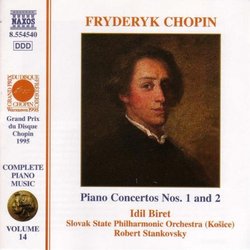| All Artists: Frederic Chopin, Robert Stankovsky, Slovak State Philharmonic Orchestra Kosice, Idil Biret Title: Chopin: Complete Piano Music, Vol. 14 Members Wishing: 0 Total Copies: 0 Label: Naxos Original Release Date: 1/1/1999 Re-Release Date: 9/28/1999 Genre: Classical Styles: Chamber Music, Forms & Genres, Concertos, Historical Periods, Classical (c.1770-1830), Instruments, Keyboard Number of Discs: 1 SwapaCD Credits: 1 UPC: 636943454022 |
Search - Frederic Chopin, Robert Stankovsky, Slovak State Philharmonic Orchestra Kosice :: Chopin: Complete Piano Music, Vol. 14
 | Frederic Chopin, Robert Stankovsky, Slovak State Philharmonic Orchestra Kosice Chopin: Complete Piano Music, Vol. 14 Genre: Classical
|
Larger Image |
CD Details |
CD ReviewsChopin's Piano Concertos Robin Friedman | Washington, D.C. United States | 11/17/2003 (5 out of 5 stars) "Frederic Chopin (1810-1849) wrote his two piano concertos in a single year, as a young man of 19 and 20 and a student at the Warsaw Conservatory. At the time, Chopin was in love with a young opera singer named Constantia Gladowska. Love shines through these two concertos, particularly in their star-lit slow movements. Chopin also wrote these concertos to perform, and to establish his pianistic and compositional skills before the public. His two piano concertos are alike in many ways, and their respective movements and forms parallel each other. These concertos are both vehicles for pianistic expression. The orchestral parts are perfunctory. The instrumentation for the orchestra is generally undistinguished with only a few solo passages in which the various instruments are allowed to stand out. With the exception of the long introductions at the beginning of each concerto and a few transition passages, the orchestra for the most part simply provides some background to the soloist. The concerto no. 2 in F minor, opus 21 was the first written of the pair. It is the more frequently performed of the two, largely because the first movement has a shorter orchestral introduction and is rather better structured. After the orchestra concludes its introduction, the piano comes to the fore and plays and repeats the lyrical themes each time with greater embellishment, trills, and passion. The second movement is one of slow, romantic yearning with a beautiful recitive section in the middle of the movement followed by a quiet passage in thirds for the piano. The third movement is a haunting mazurka. In a portion of this movement, the violins are directed to play with the wooden part of the bow. Following a brass fanfare, the movement concludes with an uptempo quicker dance full of filligree and ornamentation.The piano concerto no. 1 in E minor opus 11 features a beautiful second singing second theme in the opening movement. The first movement also has a long, dense, orchestral introduction, which makes this concerto a slower-moving work that the F minor concerto. The second movement again is a beautiful romance marked "larghetto" which features a songful, simple melody in the piano over broken chords. It has the feel of one of Chopin's nocturnes. As does the slow movement of the F minor concerto, this concerto has a beautiful declamatory section in the middle of the slow movement. The work concludes with a dance-like rondo.In spite of the criticism which has been leveled at them, these concertos are beautiful romantic works that live on the strength of the lyric piano writing.These works appear on a complete compilation of Chopin's piano music on the budget-priced Naxos label. Pianist Idel Biret was born in Turkey and studied with Corot and Kempff. These concertos could not be better played. Although the works are display-pieces for the piano, they show little of bravura or of virtuosity for its own sake. Rather they are full of lyricism and song, with the piano writing becoming more embellished, ornamented and elaborate ans the movements progress. Biret has a beautiful feel for these works and plays them with a free rhythm. She has also written an insighful essay in the liner notes on the manner in which she approaches Chopin. Her notes illuminate her performance here.This is a beautiful recording of the Chopin concertos." A grand find Mark Hennicke | A stone's throw from Carnegie Hall | 05/27/2008 (4 out of 5 stars) "Every once in a while, when we take the road less travelled, we make some grand finds. Most of the recordings of the Chopin piano concertos in my library are by performers extremely well known for these pieces, including Rubinstein, Perahia, Pollini, Pires and Argerich. Idil Biret is a name fairly new to me, though I did know of her through reading of the daunting task she undertook in recording all of Chopin's piano music. I must say that I have found this disc the Piano Cts. Nos. 1 & 2 to be quite satisfying and very much well worth having. While she does not have the refinement of Perahia, the wisdom of Rubinstein, the fire of Pollini & Argerich or the elegance of Pires in overwhelming abundance, these are high quality performances that have a great deal of the aforementioned attributes in very good measure. Addtionally, the Naxos digital sound is very pleasing & the disc is available at an attractive, affordable price. There are no staggering weaknesses here, by any means, with quite a bit to be admired. I would recommend Idil Biret's Chopin concerto cd to anyone, without any serious reservations at all. Thoroughly enjoyable!"
|

 Track Listings (6) - Disc #1
Track Listings (6) - Disc #1